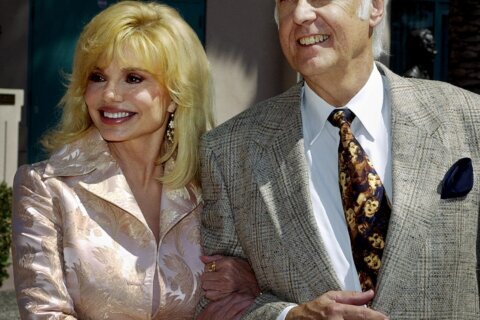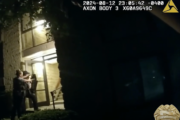WASHINGTON — There was a tragic irony to Natalie Portman’s visit to the Newseum on Thursday night for the D.C. premiere of her new film “Jackie.”
The usual excitement of a red carpet premiere contrasted with the darker pomp and circumstance of the history that unfolded along the same street in 1963, where First Lady Jackie Kennedy watched her husband President John F. Kennedy’s flag-draped coffin march from the White House to the U.S. Capitol, then to St. Matthew’s Cathedral before resting at Arlington Cemetery with an eternal flame.
Such epic proportions are a load for any film to carry, but like its heroine, “Jackie” does so with grace, transcending any claims of “Oscar bait” to achieve an artful portrait worthy of all accolades. When you see the movie — which opens in limited release on Dec. 2 before going nationwide Dec. 9 — try to remove all preconceived expectations and view it on its own terms: as a stunning character study.
“It is such an incredibly traumatic, tragic, violent event that happened to her,” Portman told WTOP. “So it’s absolutely what you would imagine emotionally, that it would range from intense grief, disorientation, anger, dark humor; it sort of allows all these different aspects of grief to come out.”
Rather than a standard biopic of her full life story, “Jackie” is an artful, even experimental look at the four days after the JFK assassination. Thus, the film avoids the trap of many mainstream biopics that try to cover too much ground. It’s better to focus on a narrow slice, be it exploring Lincoln through the 13th Amendment in “Lincoln” (2012) or MLK through the Voting Rights Act in “Selma” (2014).
“It’s really hard to try to tell the story of a person’s life by jamming everything that ever happened to them into one film,” screenwriter Noah Oppenheim told WTOP. “It’s far more illuminating … to pick a moment in time or a couple moments in time where they were going through a really intense crucible. Often times, when we’re under the most pressure, that’s when our character shines through.”
This smart choice allows Portman to hone in on the grief of those traumatic days, melting into the role like Daniel Day-Lewis as President Lincoln or David Oyelowo as Dr. King. Her tonal mastery of Jackie’s high-class voice might jar younger viewers unfamiliar with hearing “Jackie O” speak, but if you compare it to the source, it’s spot on, crafting the Camelot myth with each breathless pause.
“I didn’t have a ton of time to prepare, so it’s quite fast but it was very intense,” Portman said. “I worked with a great dialect coach. We just listened to the tapes over and over again, and watched the White House tour over and over again, so that by the time I got to set, I didn’t have to think about it.”
Beneath this artifice, Portman reveals a raw vulnerability, staggering almost catatonic around the White House in her blood-stained pink suit, listening to “Camelot” on the Victrola, then breaking down with primal, painful cries while wiping her husband’s blood off her face. It’s a performance surely worthy of her second Oscar after Darren Aronofsky’s ballet thriller “Black Swan” (2010).
It’s no surprise that Aronofsky was originally set to direct and remains one of the film’s producers, for “Jackie” is nightmarish. Chilean director Pablo Larraín, who was hailed at Cannes for “No” (2012) and the Berlin Film Festival for “El Club” (2015), crafts a haunting portrait of the former first lady with Mica Levi’s eerie score mirroring her mental state, its drooping violins plunging her into madness.
“I was invited by Darren Aronofsky, then more people got involved,” Larraín told WTOP. “I thought Natalie was essential to the project. She has not only the beauty, elegance and sophistication that Jackie had, but also she has something essential. I think Jackie Kennedy was a very mysterious person on her eyes and Natalie has that too. That’s why there’s so many close-ups in the film.”
Between the intimate close-ups, Larraín flashes back to that horrific day in Dallas in a series of memories, slowly disclosing the more graphic bits until whacking us with Zapruder explosiveness. These memory fragments are pieces of a broken mirror in what must have been a blur for Jackie.
“When you go to memory, a memory can be very particular and tough and strange,” Larraín said. “That’s what we tried to do, to create a space for memory. It has elements that are unsettling, elements that are more beautiful, just combining different layers of memory, the music there.”
Working with French cinematographer Stéphane Fontaine (“A Prophet,” “Rust & Bone”), Larraín often shows these reflective moments in mirrors, like the three-paneled bathroom mirror as Jackie puts on her pink pillbox hat. But these double images also speak to the symbolic nature of putting on faces.
“Mirrors are essential to cinema. Every camera has a mirror, especially if you work in film,” Larraín said. “Jackie was a fashion icon, so I’m telling you she looked in a mirror. Also, I think a mirror is also a beautiful way to see a reflection that’s not always the reality.”
The best example comes as Portman gazes out a car window, its reflection showing archival footage of the crowd of mourners along the parade route. Throughout, “Jackie” seamlessly intercuts archival footage with cinematic recreations, be it Portman appearing in the black-and-white footage of Jackie’s 1962 televised tour of the White House — a technique in everything from “Citizen Kane” (1941) to “Forrest Gump” (1994) — or intercut with the sepia-toned footage of the memorial service.
Keeping these fragmented images in some semblance of structure is the framing device of a Life magazine reporter (Billy Crudup) interviewing Jackie at her fancy waterfront estate in Hyannis Port, Massachusetts (Those waters have turned decidedly somber this fall after “Manchester By the Sea”).
It’s the most conventional choice in an otherwise experimental script by Oppenheim (“The Maze Runner,” “Allegiant”), who you may not know is the longtime producer of NBC’s “Today” show. Indeed, there’s a bit of Katie Couric or Savannah Guthrie within Crudup as he patiently prods Portman.
“My primary job in life has always been as a journalist, so those were especially fun scenes to write,” Oppenhiem said. “I can’t say that every interview we do is that entertaining and that much of a back-and-forth, but my life experience definitely informed that. … That [framing device] was there from the first draft onward. I always thought that interview was a good way to kind of bookend the film.”
These Hyannis Port interview scenes play out like a chess match, as Crudup carefully pries for information and Portman bottles up the truth, self-editing on the fly and speaking off the record.
“She was incredibly savvy and knew exactly what she was doing and understood this was her last opportunity to define how her husband would be remembered,” Oppenheim said. “She came up with a very powerful metaphor in Camelot … By making reference to something in pop culture like Arthurian legend, it sticks in people’s minds far more than if she had listed policy accomplishments.”
Portman herself says she was surprised at the level of Jackie’s involvement in the myth building.
“I was so surprised that she had such a role in crafting the legacy herself, that she took such a strong narrative authorship in the whole process,” Portman said. “It’s really astonishing that she had that presence of mind in those days that she was going through incredible turmoil … to author a legacy.”
While the magazine interview features a more guarded Jackie, we get far more personal glimpses in her White House encounters with Lyndon B. Johnson (John Carroll Lynch), staffer Nancy Tuckerman (Greta Gerwig), brother-in-law Bobby Kennedy (Peter Sarsgaard) who laments his legacy (“We’ll be remembered as the pretty people”) and her kids Caroline and John Jr. (“A very bad man hurt daddy”).
“We’ve all considered the JFK assassination a lot in our history books, but there’s obviously parts that … we have not considered, like what was that moment like when she had to tell the kids,” Portman said. “It’s devastating. It was one of the things I remember when I read the script for the first time; I was just crying reading it because it’s such an awful thing to have to imagine telling a kid.”
Most revealing are Jackie’s private chats with The Priest (John Hurt), where she confesses JFK’s adulterous sins: “He would wander off into the desert to be tempted by the devil, but he would always come back to us.” She also doubts her faith, saying, “What kind of God would take two babies, one in the womb and one alive just long enough for me to miss him?”). The Priest responds with a gospel story of healing a blind man, insisting her pain is a way of revealing God’s work to others.
In the end, Jackie accepts that she should stop seeking answers and live in the moment, setting the stage for her second stage of American life as Jackie Onassis. Perhaps this struggle with immortality is what drives her insistence on an Eternal Flame and an undying mythical legacy. “For one shining moment, there was a Camelot,” Jackie says, before insisting, “There won’t be another Camelot.”
The charade recalls John Ford’s “The Man Who Shot Liberty Valance” (1962): “When the legend becomes fact, print the legend.” Or as Jackie says, “The men we read about on these pages are more real than the men standing beside us.” The same goes for Best Actress winners on the red carpet.
Rating is based on a 4-star scale. See where it ranks among the year’s best movies in our Fraley Film Guide.









